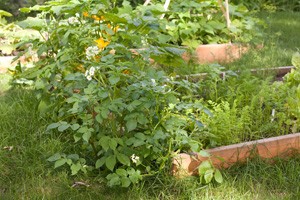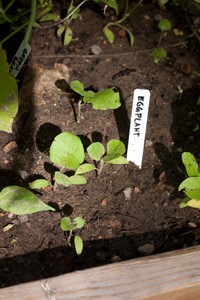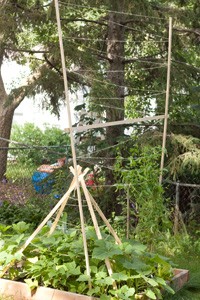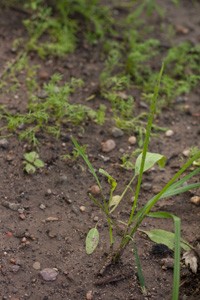 July in Minnesota marks the beginning of the season of bounty — nearly everything we grow is available now. Strawberries, snap peas, green beans, and my personal absolute favorite, raspberries. The Farmers Markets are exploding with produce. My garden? Well, it’s not quite there. I don’t have all the answers but here are some things I’ve learned so far in my first year of vegetable gardening.
July in Minnesota marks the beginning of the season of bounty — nearly everything we grow is available now. Strawberries, snap peas, green beans, and my personal absolute favorite, raspberries. The Farmers Markets are exploding with produce. My garden? Well, it’s not quite there. I don’t have all the answers but here are some things I’ve learned so far in my first year of vegetable gardening.
Some things grow faster than others
I planted my crops (mostly) based on their full height, from shortest to tallest, south to north, so each would get the most possible sunlight. What this didn’t take into account was that some plants grow faster than others — like potatoes and zucchini. I planted them at the southernmost end of my garden, assuming that zucchini don’t get tall, but instead grow out like pumpkins, and that potato plants are actually quite low to the ground, considering the actual produce is underground and that I didn’t plan to harvest them until fall. 
This was all wrong.
In fact, both are much too tall for the southern end of my garden.
They have been blocking almost all of the sunlight my precious carrots need to ensure they’ll produce before, oh, November. Carrot greens are tall, but not thick or strong — certainly not so much so that they can stand up to potatoes and zucchini. (Left photo: potatoes on the left, shading the carrots on the right.)

Speaking of plant placement…
Don’t give up in the middle of plotting your garden, or else you, too, may find you’ve planted your heat-and-sun-loving eggplants smack in between your pole beans (and their trellis), snap peas (and their trellis), and the ground-covering delicata squash leave. Or, if you are, put something that can grow equally well in sun and shade (like lettuce or radishes) — because those eggplants are having a tough go of it losing all their sun to their leafy neighbors.
The Size and Necessity of Trellises
I think most people know that snap peas are a climbing plant — but how high?
I bought three-foot dowels to make my snap peas’ trellis; by the time I got the ends sunk into the bed, there was hardly room left for them to grow on. Then I bought two eight-foot dowels (“if they’re three feet now, and you lose a bit to the ground, I should get at least another two feet, but they don’t come in six-foot lengths… I’m sure eight will be fine…”). Well, boy, do they have room to grow now!
 Another vegetable that sometimes requires trellising is green beans. I specifically intended to buy bush beans, not pole beans (which don’t need extra support). However, somewhere between poring over the seed catalog and planting them, I indeed got pole beans, which only became clear in the last few weeks when they started falling all over themselves. So: Be sure you know which ones you’re getting, and then build them an appropriate trellis.
Another vegetable that sometimes requires trellising is green beans. I specifically intended to buy bush beans, not pole beans (which don’t need extra support). However, somewhere between poring over the seed catalog and planting them, I indeed got pole beans, which only became clear in the last few weeks when they started falling all over themselves. So: Be sure you know which ones you’re getting, and then build them an appropriate trellis.
 Weed or vegetable?
Weed or vegetable?
Many of the seeds I planted I had never seen pre-supermarket before, or at least not in its fresh state. Like tarragon and chamomile. This makes it exceedingly hard to know what’s a weed (and should be pulled) and what is the delicate, delicious, flavor-creating herb that you’ve been praying would finally poke its leafy little head through the topsoil.
For all I know, a seed from another square of the bed got blown over, and that’s why it looks different. Even after it’s big enough to be identified. Sigh. That would be how I have three varieties of green matter growing in one square-foot plot.




Weed of vegetable says it all! I have such a hard time knowing whether I’m to pull or not to pull. This is part of the reason our garden became overgrown with weeds this summer (which I’m working to remedy not), but a lot of damage was done as the things I meant to grow were suffocated by weeds I wasn’t sure of. pout
@Hannah– me three! I’m so keen on weeding, but it breaks my heart when I look down to see that I’ve just pulled up the beginning of something delicious.
I had a similar problem with my tomatoes getting too huge and crowding my delicate little carrots. Should have swapped them places with the much-hardier beets. Lessons learned! I just have to make sure to keep documenting all this in my little garden journal so I don’t make the same mistakes next season!
Keep up the good work, Sara!
Yes, gardening is an ongoing learning experience and we learn something new every day. That is probably why it is so addictive. It keeps our heads going!
So, can we win free tickets to a bonfire in your garden for commenting on this? I’ve come to expect that from TCJewfolks.